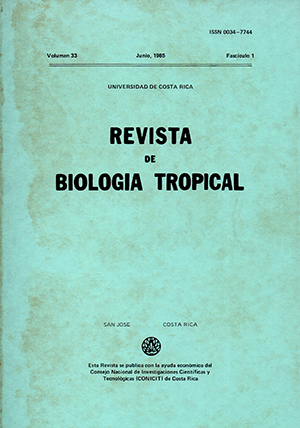Abstract
Different features of the satellite associations between the acrocentric chromosomes of 100 postpartum mothers, between 14 and 43 years of age, and 100 neonates (51 males and 49 females) from Puriscal, Costa Rica, were compared (400 cells were examined, 2 from each individual). Several types of satellite associations showed higher frequencies in the mothers than in the neonates. The associations most frequently found in the two groups were those of two chromosomes, followed by those of three chromosomes. The G/G ratio was 1.43 in the children and 1.40 in the mothers. The number of associations per cell in the mothers was almost twice that of the children. The mean number of acrocentric chromosomes per association was 2.2 in the children and 2.35 in the mothers. No significant difference was found between observed and expected values of D and G chromosomes in the two groups. Thus the probable factors responsible for the increase of satellite associations in the mothers similarly influenced the two types of acrocentric chromosomes.References
Bishun, N., J. Milis, N. LLoyd, D.C. Williams, & E. Gristwood. 1972. Chromosomal satellite association in women using oral contraceptives and their progeny. Cytologia, 37: 639-642.
Cohen, M.M., & M.W. Shaw. 1967. The association of acrocentric chromosomes in 1000 normal male metaphase cell s. Ann. Hum. Genet., 31: 129-139.
Cooke, P. 1972. Age-related variation in the number of secondary associations between acrocentric chromosomes in normal females and patients with Turner's syndrome. Humangenetik, 17: 29-35.
DiLernia, R., M.L. Riva, L. Dalora, & E. Ginelli. 1980. Satellite associations and silver staining in a case of multiple G and D variants. Hum. Genet, 53: 237-240.
Dittes, H., W. Krone, K. Bross, M. Schmid, & W. Yogel. 1975. Biochemical and genetic studies on the nucleolus organizing regions (NOR) of man. 11. A family with the 15/21 translocation. Humangenetik, 26: 47-59.
Ferguson-Smith, A.A., & S.D. Handmaker. 1961. Observations on the satellited human chromosomes. Lancet, 1: 638-640.
Galperin-Lemaitre, H., L. Hens, & B. Sele. 1980. Comparison of acrocentric associations in male and female cells. Relationship to the active nucleolar organizers. Hum. Genet., 54: 349-353.
Hansson, A. 1970 a. Differences in the satellite association pattern in the human population. Hereditas, 66: 21-30.
Hansson, A. 1970 b. The influence of culture method on the satellite association pattern in human lymphocytes: macroculture versus microculture. Hereditas, 66: 31-34.
Hansson, A. 1979 a. Associations between human acrocentric chromosomes. Resumen de tesis. Universidad de Lund, Lund, Suecia. 17 p.
Hansson, A. 1979 b. Satellite association in human me taphases. A comparative study of normal individuals, patients with Down's syndrome; and their parents. Hereditas, 90: 59-83.
Harnden, D.G. 1961. The chromosomes, p. 19-3 8. In Recent advances in human genetics. Little Brown, Boston.
Hens, L., M. Kirsch-Yolders, F.E. Arrighi, & C. Susanne. 1980. Relationship between measured chromosome distribution parameters and Ag-staining of the nucleolus organizer regions. Hum. Genet., 53: 363-370.
Kumagai, M. 1982. Influence of ageing on satellite association in human chromosomes. Acta Schol. Med. Univ. Gifu, 30: 494-510.
Liem, S.L., T.E. Denton, & K.M. Cheng. 1977. Distribution patterns of satellite association in human lymphocytes relative to age and sex. Clin. Genet., 12: 104-110.
Mattei, J.F., S. Ayme, & M.G. Mattei. 1976. Quantitative and qualitative study of acrocentric associations in 109 normal subjects. Hum. Genet., 34: 185-194.
Mattei, M.G., N. Souiah, S. Aymé, J.F. Mattei, & F. Giraud. 1981. Variabilité interindividuelle des associations entre chromosomes acrocentriques. J. Génét. Hum., 29: 181-189.
Morton, C.C., L.A. Corey, W.E. Nance, & J.A. Brown. 1981. Quinacrine mustard and nucleolar organizer region heteromorphism in twins. Acta. Genet. Med. Gemellol., 30: 39-49.
Ohno, S., J.M. Trujillo, W.D. Kaplan, & R. Kinosita. 1961. Nucleolus-organizers in the causation of chromosomal anomalies in man. Lancet, 2: 123-126.
Priest, J.H. 1977. Medical Cytogenetics and Cell Culture. Lea & Febiger, Philadelphia, 2a ed. 344 p.
Sigmund, J., H.G. Schwan acher, & A.V. Mikelsaar. 1979. Satellite association frequency and number of nucleoli depend on cell cycle duration and NOR activity: Studies on rust, second, and third mitoses of lymphocyte cultures. Hum. Genet., 50: 81-91.
Vormittag, W. 1980. Effect of age and cultivation time on acrocentric associations in females. Aktuel. Gerontol., 10: 309-318.
Warburton, D., K.C. Atwood, & A.S. Henderson. 1976. Variation in the number of genes for rRNA among human acrocentric chromosomes: correlation with frequency of satellite association. Cytogenet. Cell. Genet., 17: 221-230.
Yip, M.Y ., & D.P. Fox. 1981. Variation in pattern and frequency of acrocentric association in normal and trisomy-21 individuals. Hum. Genet., 59: 14-22.
Zakharov, A.F., A.Z. Davudov, V.A. Benjush, & N.A. Egolina. 1982. Genetic determination of NOR activity in human lymphocytes from twins. Hum. Genet., 60: 24-29.
Zang, K.D., & E. Back. 1967. Individual satellite association patterns. Lancet, 2: 1423.
##plugins.facebook.comentarios##

This work is licensed under a Creative Commons Attribution 4.0 International License.
Copyright (c) 1985 Revista de Biología Tropical


